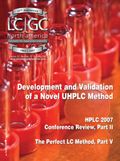Collecting Wisdom
LCGC North America
"As research advances, about half of what we will teach you . . . will turn out to be wrong. The problem is, we presently don't know which half." Powerful Medicines, Jerry Avorn, 2004
A decade or two ago, the primary users of mass spectrometers were likely graduates of doctoral programs specializing in mass spectrometry (MS). But as the science evolved and merged with the analytical mainstream, manufactures redoubled their efforts to make their instruments and operating software user-friendly. These days, specialists in various disciplines use MS as an analytical tool, a development that demands that instrument and software engineers pay close attention to ease-of-use issues and better understand how and for what purposes their instruments are used. As an example of how the needs reflect the changing field, I used some examples when teaching liquid chromatography (LC)–MS courses more than a decade ago from work that illustrated how simply changing temperature to affect viscosity, increasing flow rate, and using shorter columns made dramatic changes in the speed of an LC separation. This knowledge was hardly novel back then to a chromatographer let alone in today's world of advanced technology such as ultrahigh-pressure LC (UHPLC). Such tricks still come in handy, of course only when the separation permits, but the audience for much of the LC–MS discussion years ago consisted of mass spectrometrists who had little understanding of chromatographic fundamentals. Today's practitioners employing MS start at a much higher level of comprehension.

So, consider the number of people in analytical practices and the wealth of experience each could contribute to almost any technical discussion. Bringing those experiences to a wider audience has been the goal of this column and also the guiding charter for the Conference on Small Molecule Science (CoSMoS), which I help organize. CoSMoS starts each conference with a series of free tutorials to bring attendees to the same conversational level before engaging the topics later in the oral presentations, which are then broadly discussed in workshops. Discussions at conferences, "for-a-fee" LC–MS courses, and postings of moderated Web sites and blogs are other primary means to examine not only suiting a mass spectrometer to a given purpose but the art of employing the devices.
Jeremy Bentham in 1789 described in Introduction to the Principles of Morals and Legislation a set of assumptions — "the greatest good for the greatest number" — upon which the philosophic concept of utility is based. Of course, whatever the greatest good is for the greatest number, it brings little benefit to those not included in that number. As we established in an earlier column (1), not everyone finds that he or she falls within the "greatest good" construct.

Michael P. Balogh
So what are practitioners to do to stay abreast of technology developments in MS? As I wrote in the earlier column, simply subscribing to moderated discussion groups is a benefit easily realized. But as though gaining ground on what we need to know about MS is not difficult enough, an unapproved article showed up threatening an attack on a newsgroup. The same message was posted to many other newsgroups. The newsgroup sci.chem, for example, had about 1400 messages in a short span and all but about 10 of them were bogus.
As David Bostwick (Bioanalytical Mass Spectrometry Facility, Georgia Institute of Technology, Atlanta, Georgia), the moderator and driving force providing one of the better services to our interests points out: "The newsgroup approval process is not very secure, so messages can show up in the group without going through the moderators for approval. We do what we can, but a determined, serious hacker can cause a lot of problems. What happened here, and in many other groups, is the message approval was forged, and the article was injected directly, bypassing the moderators."
There are any number of courses provided today which, if one has the time and financial support, are an excellent source of knowledge. Well versed practitioners as well as novices might attend courses such as those given the weekend before the annual ASMS conference (www.asms.org). But the content of those courses can sometimes prove daunting for scientists who are not already well versed in MS. Courses like those offered by ACS and conferences such as EAS (www.eas.org) and FACSS (www.facss.org) are better attuned to neophytes.
Various tools exist online, some of which I track and update regularly as a list for LC–MS course handouts appear at the end of this column. Readers often suggest other useful connections, such as the ones noted by Tobias Kind recently for people who cannot pay up to $200,000 per year for the CAS Scifinder. The Chemical Structure Lookup Service or CSLS (cactus.nci.nih.gov/lookup) is a good "locator database" for small molecules. As noted on the site, the service does not "contain" any of the databases covered by it. Each database was evaluated to determine whether a certain structure occurs in it or not. CSLS comes close to matching CAS with 39 million structures while Chemspider (www.chemspider.com) boasts 16 million. Tobias is associated with Oliver Fiehn's University of California Davis laboratory in metabolomic research and is the keeper of www.AMDIS.net, which I have recommended often for general information. His own efforts discussing structural characterization by MS are well worth investigating: http://fiehnlab.ucdavis.edu/staff/kind/Metabolomics/Structure_Elucidation.
One of my favorite quotations comes from the book Powerful Medicines (Jerry Avorn, Alfred A. Knopf, 2004). Quoting one of his medical school professors, Avorn writes, "As research advances, about half of what we will teach you . . . will turn out to be wrong. The problem is, we presently don't know which half." Perhaps the most quoted figure over the last century, Albert Einstein, found his way into a plenary speech by S. James Gates, Jr. at least as paraphrased: "The unhappy fate of most theories is to be proven wrong shortly after being introduced. However, for those not so treated, at best nature says: 'Maybe'" (2).
We could approach what we know in LC–MS practice with equal caution. A colleague stridently informed me once that the presence of even a mild acid in a mobile phase would mitigate detection in negative mode of the anion in question, especially where the analyte in question was a weak anion. Obviously, according to what he knew, the assertion made sense to him. Granted, suppressing ionization of the analyte in solution would be a good reversed phase idea. But we must be careful when predicting gas-phase behavior on condensed-phase assumptions. As with my colleague, the effect of pH on electrospray ionization (ESI) mass spectra might not square with your understanding of solution-phase behavior, which involves equilibrium changes in the localized pH within droplets as desolvation proceeds. Wang and Cole's chapter in Richard Cole's book on electrospray sheds some light on why you can indeed get negative ions from acidic solutions (3).

Online Access to LCâMS Techniques and References
A classic work examines how people order their preferences and make choices to maximize their benefits according to what the authors called the "expected utility theory" (4). Much like the previous reference to Bentham's "greatest good for the greatest number" a mass spectrometer's utility is inherent in its application. Following are a few edited examples from discussion exchanges. Because more people are employing tandem quadrupole MS in their labs, the issues in these exchanges are becoming more universal.
When performing MS-MS collisionally induced dissociation (CID) of a target ion with nitrogen on analytes containing a conjugated ring, the collision gas does not produce useful fragments.
Increasing the mass of a target molecule can bring an increase in internal energy. But only a fraction of an ion's kinetic energy can be converted into internal energy to induce fragmentation. Collisions between the ions and nitrogen target-gas molecules can sometimes result in a transfer of energy from the ion to the target gas instead of dissociating the analyte ion. Low-energy CID, such as performed on a triple quadrupole, is often done by using a larger target gas such as argon or xenon. Noble gases, which are monoatomic in their structure, are preferred as target gases because they are relatively unreactive and have high ionization potentials (exciting the vibrational modes of diatomic or polyatomic target gases like nitrogen transfers energy into the target molecule).
Helium is often used for high-energy CID, being relatively inexpensive. It also results in reduced scattering of the analyte ions. The center-of-mass is smaller than larger target gases such as argon but at high collision energy results in high internal energies. Low-energy CID results in relatively narrow internal energy distributions, which means that specific fragment ions are produced at particular collision energies. Increasing the collision energy moves the center of the internal energy distribution higher but fails to change the "width" of the internal energy distribution. Low-energy CID mass spectra appear to change dramatically as the collision conditions are varied. High-energy collisions produce broader internal energy distributions and show wider ranges of fragmentation.
So, the suggestion for fragmenting the conjugated ring structure: try xenon collision gas at the highest possible collision energy. If that does not work, look at an alternative fragmentation method such as high-energy CID or a narrow internal energy distribution, but efficient technique, which produces high internal energies, surface-induced dissociation (SID).
Are the classical fragmentation rules generally attributed to Fred McLafferty's work, by which we characterize electron ionization spectra, similar to the MS-MS spectrum obtained from a triple quadrupole mass spectrometer?
In the 1990s, particle-beam LC–MS systems were readily available from various manufacturers. The particle-beam technique desolvates the liquid phase, exposing an analyte to flash vaporization in the presence of 70-eV electrons. In essence, the technique is indistinguishable from EI of any other sort. Nevertheless, the technique becomes more complicated when used with MS-MS. There are many cases for even–odd electron species where the MS-MS spectra are missing the most prominent features of the classical EI mass spectra, a phenomenon explained by rapid rearrangement in the ion source prior to ion activation. Despite some correlations, the fragmentation from the even-electron species produced in ESI is more closely related to CI fragmentation being dominated by the elimination of stable, neutral species. The exact nature of the fragmentation depends upon the internal energy distribution following ion activation, which is an instrument and method dependent process.
Normal-phase solvents — such as hexane — exhibiting very low surface tension and viscosity should produce easily evaporated sample droplets in the ESI process. Why do these solvents then exhibit poor ESI response?
ESI relies on classic liquid-phase acid–base equilibria to form ions, which can be difficult in a nonaqueous system. Some people include a hygroscopic liquid such as 2-propanol in their mobile phase (perhaps via a tee fitting postcolumn) as a way to introduce water without causing phase separation. You can perform atmospheric-pressure chemical ionization (APCI) spectrometry using a normal mobile phase, despite the presence of high heat and an "ignition point," because nitrogen floods the environment minimizing any explosive potential. Very high sensitivity results are published that rely on nonionic surfactants and organometallic analytes that use as a mobile phase 100% methylene chloride, which confers the additional benefit of being nonflammable.
Michael P. Balogh
"MS — The Practical Art" Editor Michael P. Balogh is principal scientist, LC–MS technology development, at Waters Corp. (Milford, Massachusetts); an adjunct professor and visiting scientist at Roger Williams University (Bristol, Rhode Island); and a member of LCGC's editorial advisory board.
References
(1) M.P. Balogh, LCGC 24(4), 382–388 (2006).
(2) http://www.aaas.org/news/releases/2005/0221einsteinText.shtml
(3) R.B. Cole, Electrospray Ionization Mass Spectrometry (Wiley, New York, 1997), Chapter 4.
(4) J. van Neumann and O. Morgenstern, Theory of Games and Economic Behavior (Princeton University Press, Princeton, New Jersey, 1944).

New Study Reviews Chromatography Methods for Flavonoid Analysis
April 21st 2025Flavonoids are widely used metabolites that carry out various functions in different industries, such as food and cosmetics. Detecting, separating, and quantifying them in fruit species can be a complicated process.

.png&w=3840&q=75)

.png&w=3840&q=75)



.png&w=3840&q=75)



.png&w=3840&q=75)











